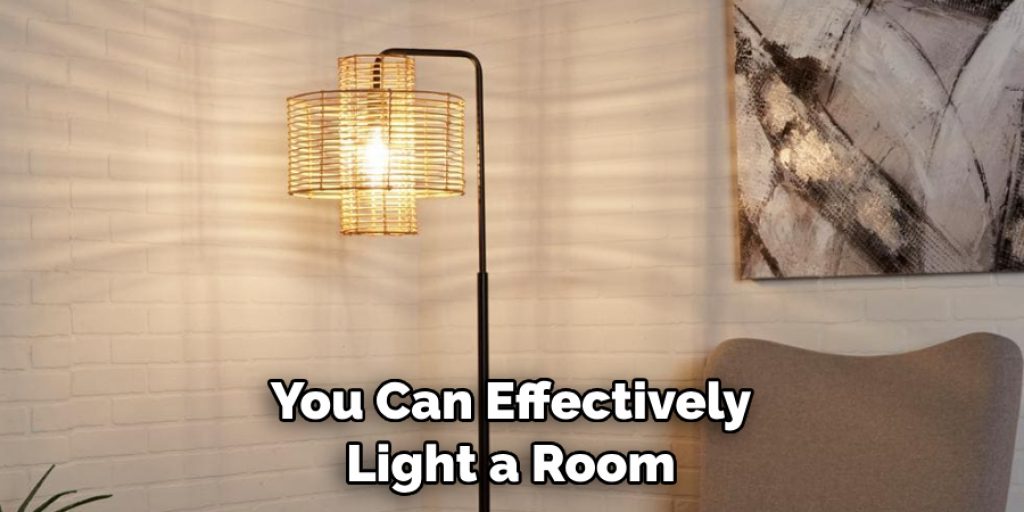How to Light a Room Without Ceiling Lights
Many homes and apartments come with traditional ceiling lights that provide a bright, overhead source of light. However, there are some spaces where a ceiling light may not be available or may not provide the desired lighting. In these situations, it can be helpful to lighten a room without ceiling lights.

The main advantage of lighting a room without ceiling lights is the flexibility it provides in creating different lighting effects. By using various techniques and light sources, you can customize the lighting in a room to suit your needs and preferences. You can find step-by-step instructions on how to light a room without ceiling lights in this blog article.
Step by Step Processes for How to Light a Room Without Ceiling Lights
Step 1: Inspect the Room
The first step is to take a close look at the room and assess its lighting needs. Consider the size of the room, its layout, and how it will be used. This will help determine the types of light sources you will need and where they should be placed.
Step 2: Choose Your Light Sources
There are various types of light sources that can be used to light a room without ceiling lights. Some options include floor lamps, table lamps, wall sconces, and string lights. Consider the style of your room and the type of lighting you want to create when selecting your light sources.
Step 3: Determine Placement
Once you have chosen your light sources, it’s important to think about where they will be placed in the room. Consider using a combination of overhead, ambient, and task lighting to create a balanced and functional space.
Step 4: Select Bulbs
When it comes to bulbs, there are many options available with different levels of brightness and color temperatures. Choose bulbs that will provide the right amount of light for your needs. For example, warmer color temperatures are better for creating a cozy atmosphere, while cooler temperatures are better for task lighting.

Step 5: Consider Dimmers
Dimmer switches can be a great addition to your lighting setup as they allow you to adjust the brightness of your lights. This is especially useful in rooms where different activities take place, such as a living room or bedroom. Strategically placing mirrors in a room can help reflect light and make the space feel brighter. This is especially useful when working with limited natural light sources.
Step 6: Add Accent Lighting
Accent lighting can add depth and interest to a room. Consider using spotlights, track lighting, or picture lights to highlight specific areas or objects in the room. If your room has windows, make the most of them by using sheer or light-colored curtains to let in natural light. You can also position mirrors opposite windows to reflect and amplify the natural light.
Step 7: Get Creative with String Lights
String lights are a fun and versatile option for adding additional lighting to a room. They can be hung on walls, draped along furniture, or wrapped around objects to create a cozy and whimsical atmosphere. Lampshades can also play a role in the type of light that is emitted. Consider using different colors or materials for your lampshades to create unique lighting effects in the room.
By following these steps, you can effectively light a room without relying on traditional ceiling lights. Whether you want to create a warm and inviting atmosphere or a functional workspace, there are plenty of options available to help you achieve the desired lighting in any room.

Tips for How to Light a Room Without Ceiling Lights
- When it comes to lighting a room without ceiling lights, you need to be extra cautious about safety. As you will be using multiple light sources, make sure they are placed on sturdy surfaces and do not pose any risks of falling or tipping over.
- Using multiple lamps or other alternative light sources also means having multiple cords and cables running through the room. Therefore, ensure that all cords are properly insulated and secured to avoid any trip hazards.
- As an extra safety precaution, use LED lights as they emit less heat compared to traditional bulbs, which can be a fire hazard if left unattended for too long.
- If you plan on using candles or tea lights for lighting, make sure to keep them away from any flammable materials and never leave them unattended.
- In case of a power outage or other emergencies, it is always good to have a flashlight or battery-powered lantern readily available. Keep one in each room for easy access.
- If you are using extension cords to connect multiple light sources, make sure they are rated for indoor use and not overloaded with too many devices.
Lastly, always turn off all lights before leaving the room or going to bed. This will not only save energy but also prevent any potential fire hazards.
Are There Any DIY Solutions for Creating Unique and Functional Lighting in a Room Without Ceiling Lights?
Lighting is an essential element in any room. It not only provides illumination but also sets the mood and ambiance of a space. However, not all rooms come with the luxury of ceiling lights. This can be due to various reasons, such as older buildings that don’t have built-in lighting fixtures or rental spaces that restrict installation of ceiling lights.
1. Natural Lighting
The first step in lighting a room without ceiling lights is to use natural light sources. This not only provides free and energy-efficient lighting but also creates a warm and inviting atmosphere in the room. Take advantage of windows, skylights or glass doors to allow natural light to enter the space. You can further improve the amount of natural light by using light-colored window treatments or mirrors strategically placed to reflect sunlight.

2. Overhead Lighting Alternatives
If you prefer a more traditional lighting setup, there are several alternatives to ceiling lights that can be used to provide overhead lighting. One option is to install wall sconces or track lighting attached to the walls. These fixtures not only add a decorative element but also provide ample lighting in the room.
Another alternative is to use floor lamps or table lamps strategically placed around the space, either directed towards specific areas or diffused for overall illumination.
3. Task Lighting
Task lighting is essential for performing specific tasks such as reading, writing, or cooking. In a room without ceiling lights, it becomes even more crucial to have proper task lighting. A desk lamp or a floor lamp with an adjustable arm can provide focused light for reading or working. For the kitchen area, under-cabinet lighting can be installed to illuminate countertops and workspaces.
4. Accent Lighting
Accent lighting is used to enhance the aesthetics of a room by highlighting specific elements such as artwork, plants or architectural features. In rooms without ceiling lights, accent lighting can be created using string lights, LED strip lights or battery-operated puck lights placed strategically around the space. These fixtures not only add a decorative touch but also provide subtle and ambient lighting in the room.
5. Creative Solutions
For those looking for more unique and creative lighting solutions, there are various DIY options to explore. One idea is to use fairy lights or string lights draped across the ceiling or walls to create a whimsical and cozy atmosphere in the room. Another option is to repurpose old lamps or light fixtures by adding new shades or bulbs to match your desired style.
For a more rustic or industrial look, you can use hanging pendant lights with exposed bulbs or mason jar lights suspended from the ceiling.

Are There Any Energy-efficient Options for Lighting a Room Without Ceiling Lights?
Lighting plays a crucial role in creating a comfortable and inviting atmosphere in any room. However, not all homes are equipped with ceiling lights, leaving many wondering how to light their space effectively. Fortunately, there are various energy-efficient options available for lighting a room without ceiling lights. In this article, we will explore these alternatives and help you find the perfect solution for your needs.
1. Natural Light
The most cost-effective and eco-friendly way to light a room without ceiling lights is by utilizing natural light. If your room has windows, you can maximize the amount of natural light coming in by keeping them clean and unobstructed. Avoid placing heavy curtains or furniture near windows that could block the light.
You may also consider adding reflective surfaces, such as mirrors, to help distribute the natural light throughout the room. Not only will you save money on lighting costs, but natural light also has numerous health benefits and can improve your mood and productivity.
2. Floor Lamps
Floor lamps are an excellent option for providing ambient or task lighting in a room without ceiling lights. They come in various styles, sizes, and designs to suit any decor, and can easily be moved around to wherever you need them. Choose LED or CFL bulbs for your floor lamps as they are energy-efficient and have a longer lifespan compared to traditional incandescent bulbs.
3. Table Lamps
Similar to floor lamps, table lamps also provide ambient or task lighting in a room without ceiling lights. They can be placed on side tables, desks, or shelves and come in various designs to match your decor. You can also opt for battery operated table lamps if you want to avoid dealing with cords and outlets.

4. Wall Sconces
Wall sconces are a great option for lighting a room without ceiling lights as they can be attached to any wall and come in various styles and sizes. They provide direct lighting, making them perfect for task lighting in areas such as reading nooks or above a desk. Some wall sconces are also dimmable, allowing you to adjust the light intensity according to your needs.
5. Track Lighting
Track lighting is an energy-efficient and versatile option for illuminating a room without ceiling lights. It consists of multiple adjustable fixtures attached to a track, allowing you to direct light wherever needed. Track lighting is perfect for highlighting specific areas such as artwork or shelves and can also be used for general lighting.
6. String Lights
String lights are not just for holiday decorations; they can also be used as a creative and energy-efficient way to light a room without ceiling lights. You can hang them on walls or ceilings, wrap them around shelves or furniture, or even place them in glass jars for a cozy and whimsical atmosphere. LED string lights are the most energy-efficient option and come in various colors and lengths.
7. Battery-powered Lights
For spaces without access to outlets, battery-powered lights offer a convenient solution. These lights can be hung or placed on surfaces to provide additional lighting as needed. They come in various designs, including puck lights, tap lights, and motion-sensor lights, making them a versatile and energy-efficient choice.

Some Additional Benefits Include
- Cost Savings: Installing new ceiling lights can be expensive, so avoiding this cost by finding alternative ways to light a room can save you money.
- Eco-Friendly: Using energy-efficient lighting options not only reduces your electricity bill but also helps in reducing your carbon footprint.
- Customizable: With various options available, you can mix and match different lighting sources to create a unique and personalized look for your room.
- Easy Installation: Most alternative lighting options are relatively easy to install, making them a DIY-friendly solution.
Conclusion
In conclusion, it is possible to create a well-lit room without the use of ceiling lights. This can be done by utilizing creative lighting techniques and incorporating different light sources in the room. One effective way to light a room without ceiling lights is by using floor lamps or table lamps. These types of lamps can provide targeted lighting for specific areas in the room. Place them strategically near seating areas or workspaces to illuminate the space.
Another option is to use wall sconces or string lights. Wall sconces can be mounted on the walls and provide both ambient and task lighting. String lights, on the other hand, can add a warm and cozy atmosphere to the room while also providing enough light for daily activities. I hope reading this post has helped you learn how to light a room without ceiling lights. Make sure the safety precautions are carried out in the order listed.




